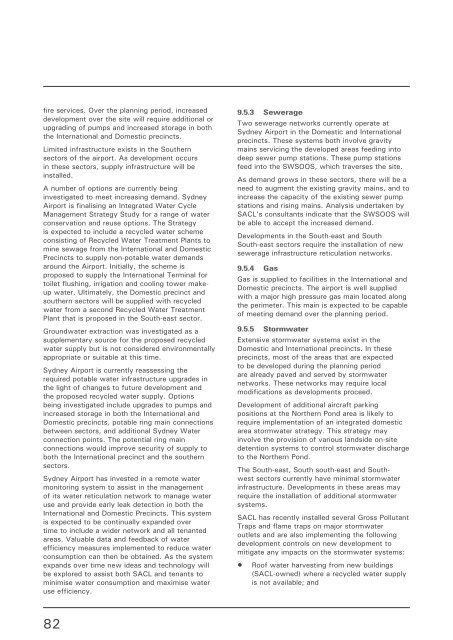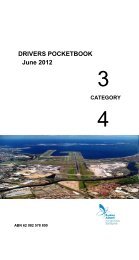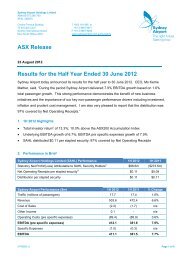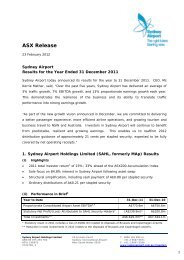Master Plan 2009 - Sydney Airport
Master Plan 2009 - Sydney Airport
Master Plan 2009 - Sydney Airport
Create successful ePaper yourself
Turn your PDF publications into a flip-book with our unique Google optimized e-Paper software.
fire services. Over the planning period, increased<br />
development over the site will require additional or<br />
upgrading of pumps and increased storage in both<br />
the International and Domestic precincts.<br />
Limited infrastructure exists in the Southern<br />
sectors of the airport. As development occurs<br />
in these sectors, supply infrastructure will be<br />
installed.<br />
A number of options are currently being<br />
investigated to meet increasing demand. <strong>Sydney</strong><br />
<strong>Airport</strong> is finalising an Integrated Water Cycle<br />
Management Strategy Study for a range of water<br />
conservation and reuse options. The Strategy<br />
is expected to include a recycled water scheme<br />
consisting of Recycled Water Treatment <strong>Plan</strong>ts to<br />
mine sewage from the International and Domestic<br />
Precincts to supply non-potable water demands<br />
around the <strong>Airport</strong>. Initially, the scheme is<br />
proposed to supply the International Terminal for<br />
toilet flushing, irrigation and cooling tower makeup<br />
water. Ultimately, the Domestic precinct and<br />
southern sectors will be supplied with recycled<br />
water from a second Recycled Water Treatment<br />
<strong>Plan</strong>t that is proposed in the South-east sector.<br />
Groundwater extraction was investigated as a<br />
supplementary source for the proposed recycled<br />
water supply but is not considered environmentally<br />
appropriate or suitable at this time.<br />
<strong>Sydney</strong> <strong>Airport</strong> is currently reassessing the<br />
required potable water infrastructure upgrades in<br />
the light of changes to future development and<br />
the proposed recycled water supply. Options<br />
being investigated include upgrades to pumps and<br />
increased storage in both the International and<br />
Domestic precincts, potable ring main connections<br />
between sectors, and additional <strong>Sydney</strong> Water<br />
connection points. The potential ring main<br />
connections would improve security of supply to<br />
both the International precinct and the southern<br />
sectors.<br />
<strong>Sydney</strong> <strong>Airport</strong> has invested in a remote water<br />
monitoring system to assist in the management<br />
of its water reticulation network to manage water<br />
use and provide early leak detection in both the<br />
International and Domestic Precincts. This system<br />
is expected to be continually expanded over<br />
time to include a wider network and all tenanted<br />
areas. Valuable data and feedback of water<br />
efficiency measures implemented to reduce water<br />
consumption can then be obtained. As the system<br />
expands over time new ideas and technology will<br />
be explored to assist both SACL and tenants to<br />
minimise water consumption and maximise water<br />
use efficiency.<br />
82<br />
9.5.3 Sewerage<br />
Two sewerage networks currently operate at<br />
<strong>Sydney</strong> <strong>Airport</strong> in the Domestic and International<br />
precincts. These systems both involve gravity<br />
mains servicing the developed areas feeding into<br />
deep sewer pump stations. These pump stations<br />
feed into the SWSOOS, which traverses the site.<br />
As demand grows in these sectors, there will be a<br />
need to augment the existing gravity mains, and to<br />
increase the capacity of the existing sewer pump<br />
stations and rising mains. Analysis undertaken by<br />
SACL’s consultants indicate that the SWSOOS will<br />
be able to accept the increased demand.<br />
Developments in the South-east and South<br />
South-east sectors require the installation of new<br />
sewerage infrastructure reticulation networks.<br />
9.5.4 Gas<br />
Gas is supplied to facilities in the International and<br />
Domestic precincts. The airport is well supplied<br />
with a major high pressure gas main located along<br />
the perimeter. This main is expected to be capable<br />
of meeting demand over the planning period.<br />
9.5.5 Stormwater<br />
Extensive stormwater systems exist in the<br />
Domestic and International precincts. In these<br />
precincts, most of the areas that are expected<br />
to be developed during the planning period<br />
are already paved and served by stormwater<br />
networks. These networks may require local<br />
modifications as developments proceed.<br />
Development of additional aircraft parking<br />
positions at the Northern Pond area is likely to<br />
require implementation of an integrated domestic<br />
area stormwater strategy. This strategy may<br />
involve the provision of various landside on-site<br />
detention systems to control stormwater discharge<br />
to the Northern Pond.<br />
The South-east, South south-east and Southwest<br />
sectors currently have minimal stormwater<br />
infrastructure. Developments in these areas may<br />
require the installation of additional stormwater<br />
systems.<br />
SACL has recently installed several Gross Pollutant<br />
Traps and flame traps on major stormwater<br />
outlets and are also implementing the following<br />
development controls on new development to<br />
mitigate any impacts on the stormwater systems:<br />
• Roof water harvesting from new buildings<br />
(SACL-owned) where a recycled water supply<br />
is not available; and







